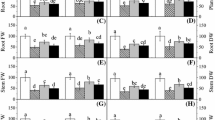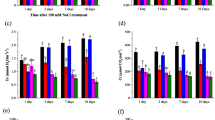Abstract
Soil salinity is a major abiotic stress that is constraining crop growth and productivity. Greenhouse hydroponic experiments were performed using salt-sensitive (cv. Zhongmian 41) and tolerant (Zhong 9806) cotton seedlings to evaluate how different genotypes responded to salinity stress in the presence of exogenous GSH (reduced glutathione). Cotton plants grown in 150 mM NaCl showed severe reduction in plant height, root length, and shoot and root fresh/dry weight. Salinity also caused reduction in photosynthesis and chlorophyll content, but increase in malondialdehyde (MDA) content. However, the reduction was more in Zhongmian 41 compared to Zhong 9806. Importantly, Sodium concentration was increased in the two genotypes and the induction was more in Zhongmian 41. Calcium and magnesium concentration was decreased in Zhongmian 41; however, in Zhong 9806 there were no significant differences relative to control. Addition of 50 mg L−1 GSH in150 mM NaCl solution (Na + GSH) significantly alleviated salinity stress. Compared with salinity treatment alone (NaCl), Na + GSH increased fresh and dry weight of the root, stem, and leaf, photosynthesis, and chlorophyll content. Obvious ultrastructural alterations were observed in the saline-treated leaf- and root-tip cells. Exogenous GSH greatly ameliorated the salinity-induced damage on the leaf/root ultrastructure, especially in Zhongmian 41.These results advocate a positive role for GSH in alleviation of salinity, which is related to significant improvement in chlorophyll content, photosynthetic performance, and leaf/root ultrastructure.






Similar content being viewed by others
References
Ahmad P, Prasad MNV (2012) Abiotic stress responses in plants: metabolism, productivity and sustainability. Springer, New York
Ahmed IM, Dai HX, Zheng W, Cao FB, Zhang GP, Sun DF, Wu FB (2013) Genotypic differences in physiological characteristics in the tolerance to drought and salinity combined stress between Tibetan wild and cultivated barley. Plant Physiol Biochem 63:49–60
Amini F, Ehsanpour AA (2005) Soluble proteins, proline, carbohydrates and Na /K changes in two tomato (Lycopersicon esculentimill) cultivars under in vitro salt stress. Amer J Biochem Biotech 1(4):212–216
Apel K, Hirt H (2004) Reactiveoxygenspecies:metabolism,oxidative stress, and signal transduction. Annl Rev Plant Biol 55:373–399
Ben Amor M, Ben HK, Debez A, Grignon C, Abdelly C (2005) Physiological and antioxidant responses of the perennial halophyte Crithmummaritimum to salinity. Plant Sci 168:889–899
Brugnoli E, Björkman O (1992) Growth of cotton under continuous salinity stress: influence on allocation pattern, stomatal and non-stomatal components of photosynthesis and dissipation of excess light energy. Planta 187:335–347
Bruns S, Hecht-Buchholz C (1990) Light and electron-microscope studies on the leaves of several potato cultivars after application of salt at various developmental stages. Potato Res 33:33–41
Chachar QI, Solangi AG, Verhoef A (2008) Influence of sodium chloride on seed germination and seedlingroot growth of cotton (Gossypium hirsutum L.). Pak J Bot 40(1):183–197
Chaparzadeh N, Amico ML, Nejad RK, Izzo R, Izzo FN (2004) Antioxidative responses of Calendula officinalis under salinity conditions. Plant Physiol Biochem 42:695–701
Chen FM (1984) Determining the chlorophyll contents of plant leaves by acetone/ethanol mixture assay. For Sci Commun 2:4–8
Chen F, Wang F, Wu FB, Mao WH, Zhang GP, Zhou MX (2010) Modulation of exogenous glutathione in antioxidant defense system against Cd stress in the two barley genotypes differing in Cd tolerance. Plant Physiol Biochem 48:663–672
El-Banna Y, Attia T (1999) Root tip meristematic cell and leaf chloroplast structure in three barley (H. vulgare L.) genotypes exposed to salinity stress. Cytologia 64:69–76
Farquhar GD, Sharkey TD (1982) Stomatal conductance and photosynthesis. Ann Rev Plant Physiol 33:317–345
Gossett DR, Millhollon EP, Lucas MC (1994a) Antioxidant response to NaCl stress in salt-tolerant and salt-sensitive cultivars of cotton. Crop Sci 34:706–714
Gossett DR, Millhollon EP, Lucas MC, Banks SW, Marney MM (1994b) The effects of NaCl on antioxidant enzyme activities in callus tissue of salt-tolerant and salt-sensitive cultivars (Gossypium hirsutum L.). Plant Cell Rep 13:498–503
Higbie SM, Wang F, Stewart JMD, Sterling TM, Lindemann WC, Hughs E, Zhang J (2010) Physiological response to salt (NaCl) stress in selected cultivated tetraploid cottons. Int J Agron 1:1–12
James RA, Blake RC, ByrtCS MR (2011) Majorgenes for Na+ exclusion, Nax1 and Nax2 (wheat HKT1;4 and HKT1;5),decrease Na+ accumulation in bread wheat leaves under saline and waterlogged conditions. J Exp Bot 62:2939–2947
Katsuhara M, Kawasaki T (1996) Salt stress induced nuclear and DNA degradation in Meris-tematic cells of barley roots. Plant Cell Physiol 37(2):169–173
Khan MA (2001) Experimental assessment of salinity tolerance of Ceriop stagal seedlings and saplings from the Indus delta. Pakistan Aquat Bot 70:259–268
Lin J, Sun YQ, Li YJ, Zhu S (2006) Studies on the effects of the salinity priming on the NaCl tolerance of transgenic insect-resistant cotton (Gossypium hirsutum L). Cotton Sci 18(6):338–341
Mahmood T, Iqbal N, Raza H, Qasim M, Ashraf Y (2010) Growth modulation and ion portioning in salt stressed sorghum (Sorghum bicolor L.) by exogenous supply of salicylic acid. Pak J Bot 42(5):3047–3054
Mendoza-Cózatl D, Loza-Tavera H, Hernández-Navarro A, Moreno-Sánchez R (2005) Sulfur assimilation and glutathione metabolism under cadmium stress in yeast, photosynthetic protists and plants. FEMS Microbiol Rev 29:653–671
Meneguzzo S, Navarri-Izzo F, Izzo R (1999) Antioxidative responses of shoots and roots of wheat to increasing NaCl concentrations. J Plant Physiol 155:274–280
Mitsuya S, Takeoka Y, Miyake H (2000) Effects of sodium chloride on foliar ultrastructure of sweet potato (Ipomoea batatas Lam.) plantlets grown under light and dark conditions in vitro. J Plant Physiol 157:661–667
Mullineaux PM, Rausch T (2005) Glutathione, photosynthesis and the redox regulationofstress-responsive gene expression. Photosyn Res 47:459–474
Munns R (2005) Genes and salt tolerance: bringing them together. New Phytol 167:645–663
Munns R, Tester M (2008) Mechanisms of salinity tolerance. Ann Rev Plant Biol 59:651–681
Oertli JJ (1991) Nutrient management under water and salinity stress. In: Proceeding of the symposium on nutrient management for sustained productivity. Department of Soils Punjab Agricultural University Ludhiana, India, pp. 138–165
Parida AK, Das AB, Mittra B (2004a) Effects of salt on growth, ion accumulation photosynthesis and leaf anatomy of the mangrove, Bruguiera parviflora. Trees Struc Func 18:167–174
Poljakoff-Mayber A (1982) Biochemical and physiological responses of higher plants to salinity stress. In: San Prieto A (ed) Biosaline research. A look to the future, New York, NY: Plenum Press, pp. 245–270f
Rahnama A, James RA, PoustiniK MR (2010) Stomatal conductance as a screen for osmotic stress tolerance in durum wheat growing in saline soil. Func Plant Biol 37(3):255–263
Scalet M, Federice R, Guido MC, Manes F (1995) Peroxidase activity and polyamine changes in response to ozone and simulated acid rain in Aleppo pine needles. Environ Exp Bot 35:417–425
Sekmen AH, Turkan I, Takio S (2007) Differential responses of antioxidative enzymes and lipid peroxidation to salt stress in salt-tolerant plant ago maritima and salt-sensitive plant agomedia. Physiol Plant 131:399–411
Song G, Yamaguchi K (2003) Efficient Agroinfiltration-mediated transient expression system of assaying different parameters in rice. Plant Biotech 20:235–239
Soussi M, Ocaòa A, Liuch C (1998) Effects of salt stress on growth, photosynthesis and nitrogen fixation in chick-pea (Cicer arietinum L.). JExp Bot 49:1329–1337
Tang Q, Feng M (1997) Practical statistics and its DPS statistics software package. China Agriculture Press, Beijing
Torres-Schumann S, Godoy J, Pentor-Toro J, Moreno F, Rodrigo R, Garcia-Herdugo G (1989) NaCl effects on tomato seed germination, cell activity and ion allocation. J Plant Physiol 135:228–232
Wu FB, Zhang GP, Dominy P (2003) Four barley genotypes respond differently to cadmium: lipid peroxidation and activities of antioxidant capacity. Environ Exp Bot 50:67–78
Wu FB, Wu HX, Zhang GP, Bachir DML (2004) Differences in growth and yield in response to cadmium toxicity in cotton genotypes. J Plant Nutr Soil Sci 167:85–90
Zhao KF, Fan H, Song J (2002) Species, types, vegetation of halophytes in China and its economic potential. In: Utilization of halophytes and sustainable development of local agriculture. China Meteorological Press, Beijing, pp. 1–9
Zhou K, Ye W, Wang J, Wang D, Fan B, Wang S (2011) Cloning and salt-tolerance analysis of gene plastid transcriptionally active (GhPTAC) from Gossypium hirsutum L. Acta Agron Sin 37(9):1551–1558
Zhu ZJ, Wei GQ, Li J, Qian QQ, Yu JQ (2004) Silicon alleviates salt stress and increases antioxidant enzymes activity in leaves of salt-stressed cucumber (Cucumis sativus L.). Plant Sci 167:527–533
Acknowledgements
This work was financially supported by the National R & D Project of Transgenic Crops of Ministry of Science and Technology of China (Major Program, 2009ZXD8001-027B).
Author information
Authors and Affiliations
Corresponding authors
Additional information
Responsible editor: Philippe Garrigues
Electronic supplementary material
Supplemental Table S1
(DOC 43 kb)
Supplemental Table S2
(DOC 45 kb)
Supplemental Table S3
(DOC 59 kb)
Supplemental Fig. S1
Effect of salinity stress and external glutathione supply on MDA content (A, B), (nmol g−1FW) in leaves of Zhongmian 41 (left panel) and Zhong 9806 (right panel) after 5, 10 and 15 d treatment expressed as the percentage of control (%). Error bars represent SD values (n = 5). Different letters indicate significant differences (P < 0.05) among the treatments and refer to each genotype. Control, Na and Na + GSH correspond to basic nutrition solution (BNS), BNS + 150 mM NaCl, and BNS + 150 mM NaCl + 50 μM GSH, respectively. (DOCX 47 kb)
Rights and permissions
About this article
Cite this article
Ibrahim, W., Ahmed, I.M., Chen, X. et al. Genotype-dependent alleviation effects of exogenous GSH on salinity stress in cotton is related to improvement in chlorophyll content, photosynthetic performance, and leaf/root ultrastructure. Environ Sci Pollut Res 24, 9417–9427 (2017). https://doi.org/10.1007/s11356-017-8611-7
Received:
Accepted:
Published:
Issue Date:
DOI: https://doi.org/10.1007/s11356-017-8611-7




